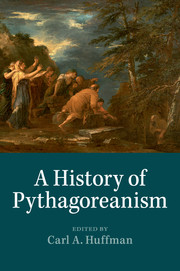Book contents
- Frontmatter
- Contents
- Contributors
- Abbreviations
- Introduction
- Chapter 1 Pythagoras
- Chapter 2 Philolaus
- Chapter 3 Archytas
- Chapter 4 Sixth-, fifth- and fourth-century Pythagoreans
- Chapter 5 The Pythagorean society and politics
- Chapter 6 The Pythagorean way of life and Pythagorean ethics
- Chapter 7 Pythagoreans, Orphism and Greek religion
- Chapter 8 The problem of Pythagorean mathematics
- Chapter 9 Pythagorean harmonics
- Chapter 10 The Pythagoreans and Plato
- Chapter 11 Aristotle on the “so-called Pythagoreans”: from lore to principles
- Chapter 12 Pythagoreanism in the Academic tradition: the Early Academy to Numenius
- Chapter 13 The Peripatetics on the Pythagoreans
- Chapter 14 Pythagoras in the historical tradition: from Herodotus to Diodorus Siculus
- Chapter 15 The pseudo-Pythagorean writings
- Chapter 16 Pythagoreans in Rome and Asia Minor around the turn of the common era
- Chapter 17 Diogenes Laertius’ Life of Pythagoras
- Chapter 18 Porphyry's Life of Pythagoras
- Chapter 19 Iamblichus’ On the Pythagorean Life in context
- Chapter 20 Pythagoras and Pythagoreanism in late antiquity and the Middle Ages
- Chapter 21 Pythagoras in the Early Renaissance
- Bibliography
- General index
- Index locorum
- Greek index
Chapter 9 - Pythagorean harmonics
Published online by Cambridge University Press: 05 May 2014
- Frontmatter
- Contents
- Contributors
- Abbreviations
- Introduction
- Chapter 1 Pythagoras
- Chapter 2 Philolaus
- Chapter 3 Archytas
- Chapter 4 Sixth-, fifth- and fourth-century Pythagoreans
- Chapter 5 The Pythagorean society and politics
- Chapter 6 The Pythagorean way of life and Pythagorean ethics
- Chapter 7 Pythagoreans, Orphism and Greek religion
- Chapter 8 The problem of Pythagorean mathematics
- Chapter 9 Pythagorean harmonics
- Chapter 10 The Pythagoreans and Plato
- Chapter 11 Aristotle on the “so-called Pythagoreans”: from lore to principles
- Chapter 12 Pythagoreanism in the Academic tradition: the Early Academy to Numenius
- Chapter 13 The Peripatetics on the Pythagoreans
- Chapter 14 Pythagoras in the historical tradition: from Herodotus to Diodorus Siculus
- Chapter 15 The pseudo-Pythagorean writings
- Chapter 16 Pythagoreans in Rome and Asia Minor around the turn of the common era
- Chapter 17 Diogenes Laertius’ Life of Pythagoras
- Chapter 18 Porphyry's Life of Pythagoras
- Chapter 19 Iamblichus’ On the Pythagorean Life in context
- Chapter 20 Pythagoras and Pythagoreanism in late antiquity and the Middle Ages
- Chapter 21 Pythagoras in the Early Renaissance
- Bibliography
- General index
- Index locorum
- Greek index
Summary
Introduction
If we tried to begin this investigation of Pythagorean harmonics with Pythagoras himself (c. 500 BC), we would find ourselves floundering through a swamp in darkness, guided by little except Will-o’-the-Wisps, “false deluding lights,” as Dryden put it. We shall tiptoe towards this perilous territory in due course, but let us begin in clearer light and on rather more solid ground, with a remark by Ptolemaïs of Cyrene, a scholar writing several hundred years after Pythagoras died:
A kanonikos is a harmonic theorist who constructs the ratios of what is attuned. There is a difference between mousikoi and kanonikoi: the harmonic theorists who proceed on the basis of sense-perception are called mousikoi, and the Pythagorean harmonic theorists are called kanonikoi.
(Both, however, are mousikoi in the generic sense.)Ptolemaïs is the only Greek woman on record as a musical theorist. Her work is known through quotations by Porphyry, all of which are concerned with the epistemological commitments and methodologies of the various “schools” or traditions of harmonic theory. She divides them into two broad groups, distinguished by the “criteria” on which they principally rely, sense-perception in the case of one group (here called mousikoi but in other passages “Aristoxenians”), and reason, logos, in the case of the other (kanonikoi or “Pythagoreans”).
- Type
- Chapter
- Information
- A History of Pythagoreanism , pp. 185 - 203Publisher: Cambridge University PressPrint publication year: 2014
- 2
- Cited by

